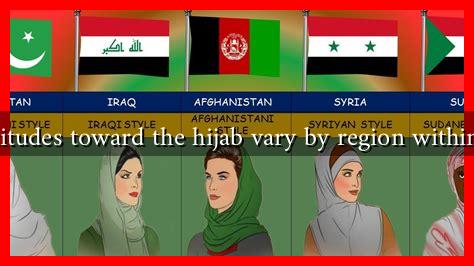-
Table of Contents
- How Do Attitudes Toward the Hijab Vary by Region Within Countries?
- The Global Context of the Hijab
- Regional Variations Within Countries
- Case Studies: Attitudes in Specific Regions
- 1. The Middle East: A Complex Landscape
- 2. Europe: A Divided Opinion
- 3. North America: A Growing Acceptance
- Statistics and Surveys
- Conclusion: The Hijab as a Symbol of Identity
How Do Attitudes Toward the Hijab Vary by Region Within Countries?
The hijab, a traditional headscarf worn by many Muslim women, has become a symbol of both faith and identity. However, attitudes toward the hijab can vary significantly not only between countries but also within different regions of the same country. This article explores how cultural, social, and political factors influence these attitudes, providing insights into the complexities surrounding the hijab in various contexts.
The Global Context of the Hijab
Globally, the hijab is often viewed through a lens of cultural and religious significance. In many Muslim-majority countries, it is seen as a symbol of modesty and piety. However, in secular or non-Muslim-majority countries, the hijab can be a point of contention, often associated with debates about women’s rights, freedom of expression, and cultural integration.
Regional Variations Within Countries
Within countries, regional attitudes toward the hijab can differ dramatically. These variations are influenced by factors such as urban versus rural settings, historical context, and the presence of diverse communities. Below are some examples of how attitudes toward the hijab can vary within specific countries:
- France: In urban areas like Paris, the hijab is more accepted, with many women choosing to wear it as a personal expression of faith. However, in rural areas, there may be more conservative views, leading to social stigma against hijab-wearing women.
- Turkey: Historically, Turkey has oscillated between secularism and Islamism. In metropolitan areas like Istanbul, wearing the hijab is increasingly accepted, while in more conservative regions, it may be seen as a necessity.
- India: In states like Kerala, the hijab is widely accepted and worn by many Muslim women. Conversely, in regions with significant Hindu populations, such as Uttar Pradesh, wearing a hijab can lead to discrimination and social exclusion.
Case Studies: Attitudes in Specific Regions
To further illustrate the regional variations in attitudes toward the hijab, we can examine specific case studies:
1. The Middle East: A Complex Landscape
In countries like Saudi Arabia, the hijab is mandated by law, and women are expected to wear it in public. However, in neighboring countries like the United Arab Emirates, women have more freedom to choose whether or not to wear the hijab. This difference highlights how cultural norms and legal frameworks shape attitudes toward the hijab.
2. Europe: A Divided Opinion
In Europe, attitudes toward the hijab can be polarized. For instance, in countries like Germany, there is a growing acceptance of the hijab among younger generations, particularly in urban areas. However, in countries like France, the secularist approach has led to a ban on wearing religious symbols in public schools, creating tension between cultural identity and national values.
3. North America: A Growing Acceptance
In the United States and Canada, attitudes toward the hijab are generally more accepting, especially in multicultural urban centers. However, incidents of Islamophobia can lead to negative perceptions and discrimination against hijab-wearing women, particularly in the wake of global events that fuel anti-Muslim sentiment.
Statistics and Surveys
Surveys conducted by organizations such as Pew Research Center reveal significant insights into public attitudes toward the hijab:
- In a 2017 survey, 62% of Muslims in the U.S. reported that they felt comfortable wearing the hijab in public.
- In France, a 2019 study found that 70% of respondents believed that the hijab should be banned in public spaces, reflecting a significant divide in public opinion.
Conclusion: The Hijab as a Symbol of Identity
Attitudes toward the hijab are complex and multifaceted, varying significantly by region within countries. These differences are shaped by cultural, social, and political factors that influence how the hijab is perceived. As societies continue to evolve, so too will the conversations surrounding the hijab, making it essential to approach this topic with sensitivity and an understanding of its diverse meanings. Ultimately, the hijab remains a powerful symbol of identity for many women, reflecting their personal beliefs and cultural heritage.
For further reading on this topic, you can explore resources from the Pew Research Center and other academic studies that delve into the sociocultural dynamics surrounding the hijab.

